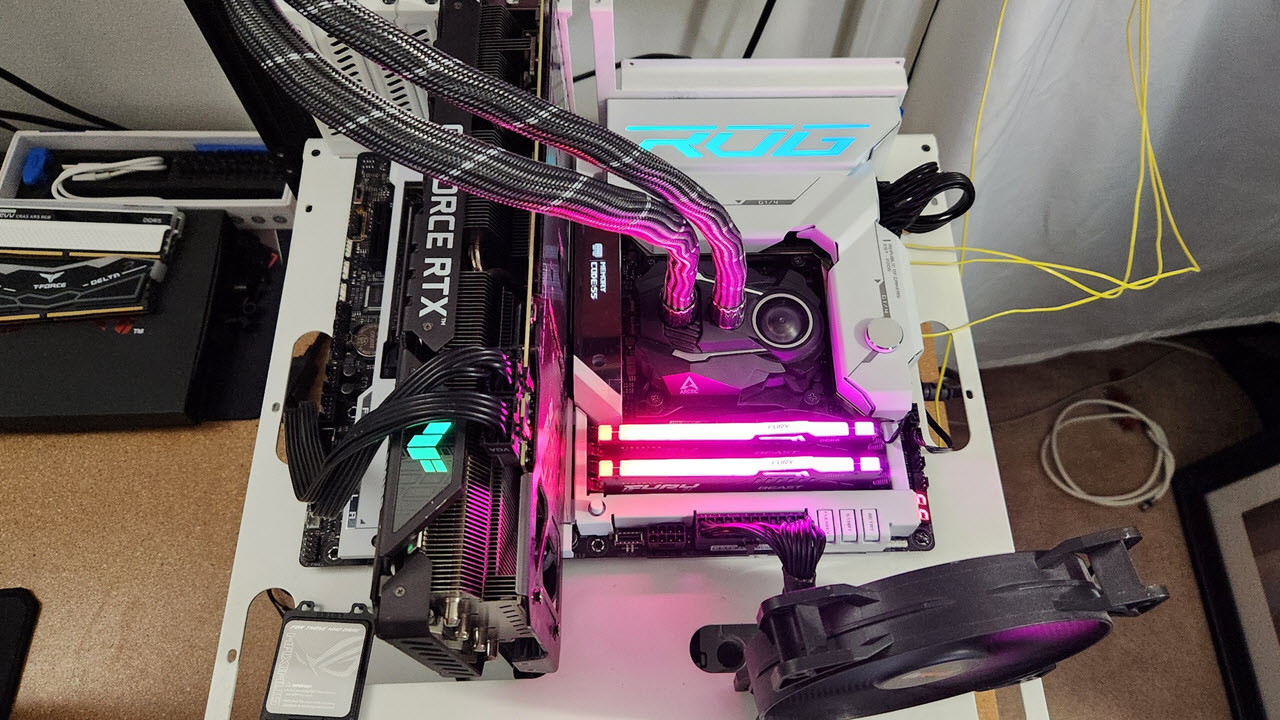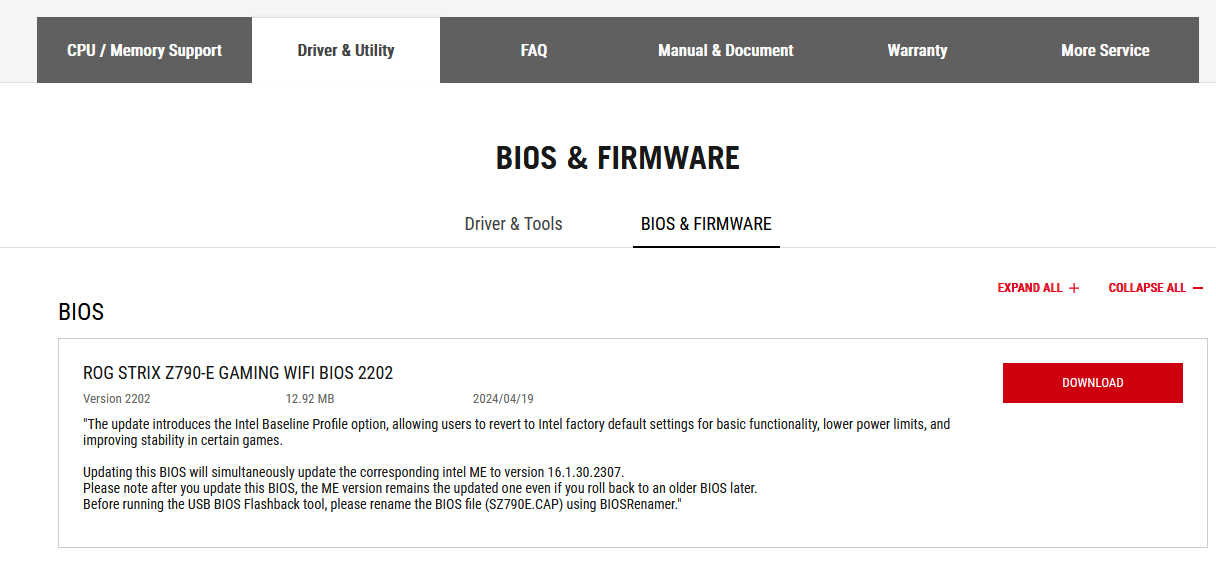New firmware addresses Intel CPU gaming instability — Asus Intel Baseline Profile fixes crashing on Raptor Lake and Raptor Lake Refresh chips
Asus addresses the instability issue by lowering its power limit and using Intel's recommended setting.

Asus released a new BIOS that adds a setting aptly named 'Intel Baseline Profile,' which switches from the motherboard's default settings to the ones recommended by Intel. It is in response to a widespread crash and another instability issue with certain games using Unreal Engine 5, precisely when it initiates shaders during the loading screen. With this setting, those with Intel 13th and 14th-generation CPUs should have stable gameplay. Once other vendors do the same, they may permanently address the issue.
Asus put up a separate page linking its respective motherboards with Z790, B760, and H770 chipsets towards the new BIOS for easy reference. The BETA BIOS listing specifies that this profile reverts to Intel's default setting, which involves lowering power limits. As a result, it seems to be addressing this nuisance.
Over the months, users found strange crashes and random BSOD while playing games using Unreal Engine 5, which many eventually narrowed down to the CPU settings used by motherboard vendors. The motherboards from multiple vendors used a very high power limit, allowing the CPU to pull higher power with some safeguards turned off. Many users experienced various issues, including 'Out of memory' issues with VRAM. Upon investigation, the crashes happen when it loads the initial shader compilation during the loading screen.
While this affects CPUs from both generations, many complaints are from users with Core i9-13900K and Core i9-14900K, Core i7-14700K, and Core i7-13700K. The instability issue plagued games made by developers like Gearbox and Fatshark, which led to many developers recommending downclocking these CPUs. According to our investigation, multiple games crashed over 90% of the time during the shader compiling process despite having stock settings set in their BIOS. It was getting clear that the blame was not on the games or the engine itself.
While there were many plausible explanations for this issue, the cause was the aggressive settings motherboard vendors were using by default. Asus' note about its beta BIOS suggests lowering the power limit and using Intel's settings. If it is that simple, it's simply a matter of time before all motherboard vendors follow suit.
While the fix is appreciated, one would ask about the necessity of having such an aggressive setting enabled out of the box without having the function to revert to Intel's settings should a crash occur. That setting enabled by default to squeeze an extra morsel of performance has no value if it crashes when it shouldn't- or worse. Not all CPUs can easily accommodate such settings; hence, tweaking a 'one-size-fits-all' profile to the extreme is not a good idea.
Regardless, some, if not all, of these CPUs have been recommended for gaming, at times bundled with a motherboard for a good deal. It's also best if respective motherboard vendors flash newly manufactured motherboards with such BIOS that address this problem from day 1.
Get Tom's Hardware's best news and in-depth reviews, straight to your inbox.

Roshan Ashraf Shaikh has been in the Indian PC hardware community since the early 2000s and has been building PCs, contributing to many Indian tech forums, & blogs. He operated Hardware BBQ for 11 years and wrote news for eTeknix & TweakTown before joining Tom's Hardware team. Besides tech, he is interested in fighting games, movies, anime, and mechanical watches.
-
hotaru251 i'll say it: every "default" bios should be the CPU makers default requirement settings.Reply
They make the chip & know it best and if you want to mess with that make it the optional settings.
Stability > performance for 90% of PC users. -
atomicWAR Glad to see this was addressed quickly. Hopefully this will be the end of instablity issues for intel. I look forward to someone posting some test results on a previoisly unstable cpu (looking at you Jarred...hope this helps you).Reply -
endocine Just love it when the overpriced, overstylized, RGB blinged out motherboard that doesn't have a debug LED fries my CPU because the manufacture wanted to rice it out for me.Reply -
TerryLaze ReplyWhile this affects CPUs from both generations, many complaints are from users with Core i9-3900K
Is this some secret CPU sku that only reviewers get?! :p
Also which "Intel's settings" does it revert to?! Since intel has at least two settings for each CPU, and at least three for the ks models. -
NinoPino Reply
Good news for Intel's owners, hope to see very soon both stability and performance tests.mangokr said:Should be "default" not and option!
It is interesting that with the passing of time we are losing both the utility but also the real meaning of word "de-fault".😀 -
PCWarrior It should be mentioned that this will probably not solve the issue entirely. It will certainly work for new builds and new installations of the operating system. But those who have been running their PCs not 100% stable probably already have corrupted operating systems and need a fresh OS installation, especially if it’s Windows.Reply -
TerryLaze Reply
How would shader compiling influence any windows files?PCWarrior said:It should be mentioned that this will probably not solve the issue entirely. It will certainly work for new builds and new installations of the operating system. But those who have been running their PCs not 100% stable probably already have corrupted operating systems and need a fresh OS installation, especially if it’s Windows. -
Alvar "Miles" Udell ReplyWhile the fix is appreciated, one would ask about the necessity of having such an aggressive setting enabled out of the box without having the function to revert to Intel's settings should a crash occur.
I'll tell you exactly why: Tech sites and social media "influencers", TomsHardware included. So much emphasis is placed on overclocking and even stock performance in reviews that it is to their advantage to do whatever they can to increase performance over the competition, even if it means running it outside of Intel's spec because when something like this happens then it's Intel who is getting the blame from all sides, from game developers, nVidia, and even tech sites, not the motherboard manufacturers.
Tech sites, "influencers", and especially Intel need to call them out for it and even prevent them from shipping systems which default run outside of Intel's spec.
Just pray Intel doesn't turn their system into something like AMD's idiotic system that...doesn't work. -
Alvar "Miles" Udell ReplyPCWarrior said:It should be mentioned that this will probably not solve the issue entirely. It will certainly work for new builds and new installations of the operating system. But those who have been running their PCs not 100% stable probably already have corrupted operating systems and need a fresh OS installation, especially if it’s Windows.
DISM and SFC is your friend.
